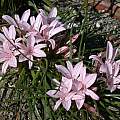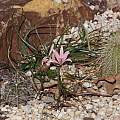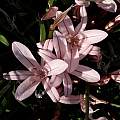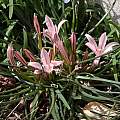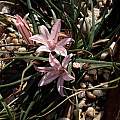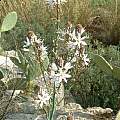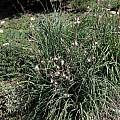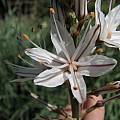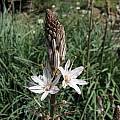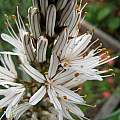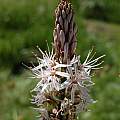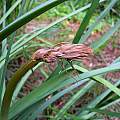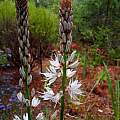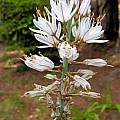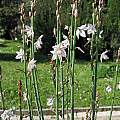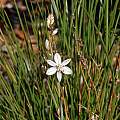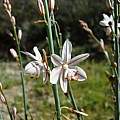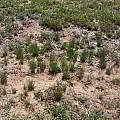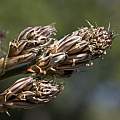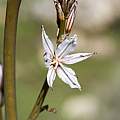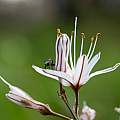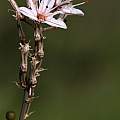Asphodelus is a genus of about 20 species in the Asphodelaceae family. They are native to Europe, North Africa, and Asia, but primarily the Mediterranean. Many have a small rhizomatous crown and thick, fleshy roots.
Asphodelus acaulis Desf. forms basal rosettes of narrow, succulent leaves and produces peach-pink flowers in early spring on short stems. It is the only low-growing member of the genus and is native to the mountains of Algeria and Morocco. Height range: 10-15 cm. The pictured plants in the first photo by Jane McGary are growing in a bulb frame in Oregon, kept dry in summer. Propagation is by seed or division of the dormant crowns; the older crowns may die after flowering. Photos 2-5 were taken by John Lonsdale.
Asphodelus aestivus Brot. is a well-known element of Mediterranean flora, associated with overly-grazed pastures and shallow soils, being fire and grazing resistant. Plants are rather showy in bloom and occasionally harvested as cut flowers by day trippers. Because of this, it is called the 'common asphodel'. Height range: 2-4 ft. The first photo shows habitat by Angelo Porcelli. The second to fourth photos by Nhu Nguyen were taken at the UC Botanical Garden, Berkeley where they bloom well every April.
Asphodelus albus Mill., also native to the Mediterranean, has starry white flowers with brown stripes down the middle of the tepals. PBS list member Jane McGary cautions that it can look messy when it goes dormant in late summer and recommends deadheading it so it will look better and to prevent enthusiastic self-seeding. She states mature plants are very easy to divide when dormant, and seedlings flower in their second or third year. Predators do not seem to touch it. Height range: 2-4 ft. The first photo from Max Withers of it in flower in the San Francisco bay area, where it thrives. The second photo from Hans Joschko. The last four photos were taken by Mary Sue Ittner showing the progression from bud, flowers, and fruit.
Asphodelus fistulosus L. has smaller flowers with wider petals, similarly striped. Also native to the Mediterranean, and weedy in other Mediterranean climates including California, though the tag on these plants, in the Orto Botanico in Rome, indicated that it is red-listed in Lazio. Height range: 20-70 cm. The first photo was taken by Max Withers. The rest of the photos from Calflora were taken by Ron Vanderhoff in Orange County, California, (where it is considered a weed) May 2022 and shared under a CC BY-NC license.
Asphodelus ramosus L. grows to 150 cm, white with rush midvein, native to all countries bordering the Mediterranean Sea. A distinguishing feature of this species is the inflorescence is more branched. The first five photos were taken in Israel by Shlomit Heymann in March 2016 and February 2017, in habitat. According to Wild Flowers of Israel this species blooms January through March. Photo 6 by Yuvair was taken in February 2013 at Tel Gamma, northwestern Negev, Israel, and shared under CC-BY license.
